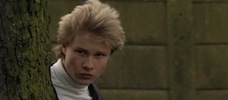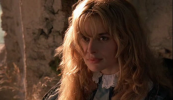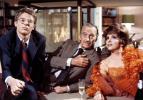Reviews
Acque di primavera
Jerzy Skolimowski
UK / France / Italy, 1989
Credits
Review by Ian Johnston
Posted on 18 August 2011
Source Miramax DVD
Categories Jerzy Skolimowski: Eros & Exile
Did Skolimowski ever wonder what went wrong in the 1980s? He started on a high with Moonlighting, a critical and commercial success, had a lot less good fortune with Success Is the Best Revenge and The Lightship (neither got the reception they deserved), and then ended up with Torrents of Spring, this rather dull, safe heritage drama. Of course, the heart does sink when the Miramax logo comes up - the Weinsteins’ brand of middlebrow literary adaptation rarely has much to offer - and sadly for most of its running time this is an unexceptional example of the genre, one in which Skolimowski has kept his idiosyncrasies in check.
Adapted from a short late novel by Ivan Turgenev, published in 1872 but set thirty years before, the film tells the story of a young Russian landowner, Dmitri Sanin, who’s on his Grand Tour of Europe. In Germany he falls in love with the daughter of an Italian confectioner, Gemma Roselli, who’s living in Frankfurt with her widowed mother and younger brother, and he’s so enraptured by this virginal beauty, who so reminds him of the Italy he’s only just left, that he proposes to and is accepted by her—in class terms, a marrying-down on his part. No sooner has he done this than he encounters Maria Nikolaevna Polozov, the wealthy wife of a childhood friend, a devouring femme fatale (there’s a lot of animal imagery in Turgenev’s descriptions of her) who seduces him. It’s hardly the case of Sanin torn between two women, rather a process whereby (as he looks back with regret later in life) he abandons Gemma and then debases himself in sexual enslavement to Maria Nikolaevna.
This is barely more than a novella, so there’s little of substance that’s omitted or elided; rather, Skolimowski, who, as opposed to some of his other literary adaptations, is responsible for the screenplay here, has made some significant additions: big scenes of a ride in a hot-air balloon, a gypsy wedding, and a Venetian masquerade party, and even a role for himself as a friend of the Polozovs. There’s a shift, too, in the authorial perspective on Sanin’s character. In Turgenev, as Sanin moves from one location (Frankfurt) to another (Wiesbaden) both his interest and the focus of the novel shift from Gemma to Maria Nikolaevna, and what’s paramount is his own self-loathing at his weakness in succumbing to this woman and accepting “all the humiliations, all the loathsome tortures of the slave […] who is cast aside at last, like a worn-out garment.” (Feminists, obviously, aren’t going to find positive role-models in either Turgenev or Skolimowski.)
Skolimowski both modernises Maria Nikolaevna - she’s given greater self-assurance, a heightened self-awareness, and in addition a peasant background, which suits Nastassja Kinski’s non-“period” style of performance - and makes her more central to the whole narrative. The distant worlds of the two women are made to meet in Skolimowski’s version. A crucial early scene in the development of Sanin’s romance with Gemma occurs when he accompanies her and her dull German-bureaucrat fiancé to a local festival. There, a military officer insults Gemma, and Sanin, rather than Gemma’s fiancé, challenges the officer to a duel. Skolimowski’s innovation is to bring Maria Nikolaevna into this scene. She’s first seen distantly observing Sanin’s interactions with Gemma (there’s an implied sexual interest here) and, as the officer’s lover, she’s the inspiration for his effrontery towards Gemma. There’s a sense that she’s pulling the strings here in a deliberate provocation and testing of Sanin.
That testing role is taken on again at the end of the film. Unbeknownst to Sanin, Maria Nikolaevna has invited Gemma to dine with the trio now formed by Sanin, herself, and her husband. This is after Sanin’s protestations of undying love and its function is to put Sanin to the test, to force him to make a choice. And it’s his weakness of character that makes him fail Maria Nikolaevna’s test as he ends up literally hugging the drapery in indecision. “Weak people never finish anything,” she accuses him. “They always need someone to finish things for them.” Sanin drifts, and in this sense he is very unlike the Skolimowskian hero, who is always motivated by a strong compulsive drive, even against his own best interests. In Sanin we get an absence of drive and, as the final sequence of the film makes clear, he is condemned as such by Skolimowski.
There is clearly a lot here in dramatic and thematic terms that attracted Skolimowski’s interest; so, what makes so much of it such a dull viewing experience? For one thing, this is a veritable Euro pudding, a Babel of competing accents from Americans, Germans, Italians, Poles, and who knows what else, some dubbed, some in their own voices, some putting on foreign accents—dubbing that, as is so often the case, undermines the whole enterprise from the start. True, Timothy Hutton as Sanin does a creditable job of more or less maintaining his Russian accent but there’s no consistency with the other Russians—Nastassja Kinski, for example, makes no attempt. And I was left with the bizarre impression that William Forsythe’s accent (he plays Maria Nikolaevna’s husband Polokov) was dubbed; certainly it was unrecognisable from the whine of Evelle Snoats or The Lightship’s Gene.
More egregious is the rather lifeless style of the film, an uninspiring parade of images reverently recreating the world of the 1840s. Obviously, with a director of Skolimowski’s proven inventiveness, there are pleasing touches—the way he rhymes the curtain that Sarin clings to in his climactic scene with an earlier one in a courting scene with Gemma; or the crane back from an overhead shot of the formal dinner party, which reveals the soundtrack music to be played by musicians in the scene. But then you get clichéed and banal sequences like the one with the gypsies.
The problem is that at heart Skolimowski isn’t suited to this style of film. He doesn’t do naturalism. His is a cinema of unpredictable digressions and diversions, of changes in mood and tempo, of sudden shifts from realism into absurdity, surrealism, or symbolism, and then back in; a cinema never still, always on the move. And it seems a recognition of this that, in Torrent of Spring’s final sequence, the film suddenly breaks the boundaries of the period adaptation, bursts into life, and takes off.
In fact this sequence has already been set up by the film’s brief pre-credits sequence (by this stage viewers may well have forgotten it) which starts with a moody long shot of a coach and horses being carried on a barge across the Venice lagoon, and then segues into an aged Sanin (Timothy Hutton in very unconvincing old man makeup) wandering around the city and being confronted with a mirror-image of himself as a white-faced harlequin clown. This is the young Sanin who, after having been tried and found wanting by Maria Nikolaevna (“It’s finished”), has, it seems, followed her to Venice. Certainly their last scene together cuts to Sanin in clown costume, surrounded by fancy-dress revellers, turning around and crying out “Maria!” And so he pursues the now unattainable Maria Nikolaevna - she briefly, distantly appears to him, the last time mockingly tossing the contents of her wine glass down towards him - jostled and pulled by partygoers, tumbling down stairs, falling over, confronted by increasing bizarre sights (an outstretched pistol that subsequently vanishes; a gypsy dancing on a table surrounded by masked men; a white horse) as he stumbles from one palazzo room to another.
It’s Skolimowski himself in his own minor role of the Polokov’s friend Victor Victorovich who brings things to a close. Mirroring Maria Nikolaevna’s “It’s finished” he declares “La commedia è finita,” and then in a voiceover takes on the persona of Turgenev’s narrator. He sums up Sanin’s failure and sense of loss, mocks him (even singing at one point), and evokes “grief, madness, poverty, blindness [… death’s] appointed hour” in a final darkening mood that adds sudden depth to the film. The sequence is so effective because it can be read simultaneously in different ways: as a hallucination generated by Maria Nikolaevna’s mention of Venice; as Sanin’s own subjective experience of the Venice trip as a nightmare; or as a symbolic summation of Sanin’s story (the pistol refers to the duel he fights, the gypsy to the wedding he and Maria Nikolaevna attend, the horse to their ride together). It’s a brilliant conclusion, which at the same time leaves one with the regret that the rest of the film didn’t operate at this level.
More Jerzy Skolimowski: Eros & Exile
-

The Shout
1978 -

Moonlighting
1982 -

The Lightship
1985 -

Success Is the Best Revenge
1984 -

Torrents of Spring
1989 -

King, Queen, Knave
1972
We don’t do comments anymore, but you may contact us here or find us on Twitter or Facebook.



